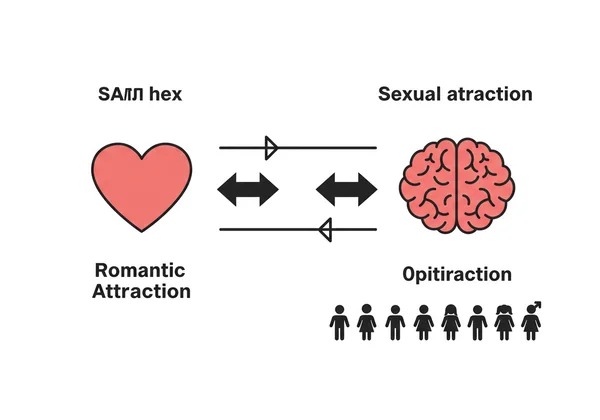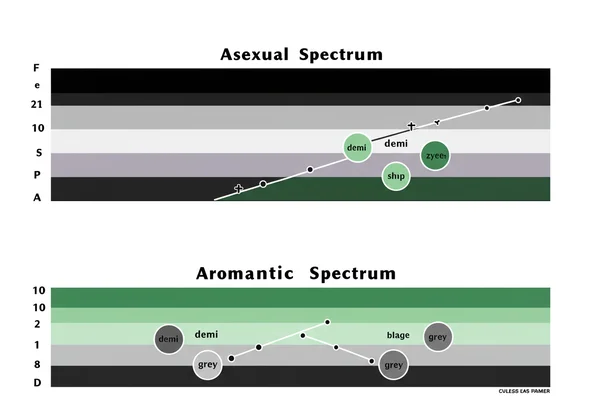Am I Gay Quiz: Understanding Sexual vs. Romantic Attraction
Have you ever felt a deep emotional connection to someone without any sexual desire? Or perhaps you've been physically attracted to people you simply can't imagine dating? If these feelings leave you confused, you're not alone, and everything you're feeling is valid. Understanding the different types of attraction is a fundamental step in your journey of self-discovery. So, how to know if I'm gay when your heart and body seem to be telling you different things?
Navigating the landscape of your own identity can feel overwhelming, especially when the words to describe your experiences aren't readily available. This guide is here to help you unpack those complex emotions. We'll explore the key differences between sexual and romantic attraction, providing you with the clarity to better understand yourself. If you're ready to make sense of your feelings, you can start exploring today with our supportive tools.
What Are the Different Types of Attraction?
Attraction isn't a single, simple feeling; it’s a rich tapestry woven from different threads. For many people, these threads are bundled together so tightly they seem like one. For others, they are distinct and point in different directions. Recognizing these separate strands is the first step toward understanding your unique identity.

Defining Sexual Attraction: The Drive for Physical Intimacy
Sexual attraction is likely the type you hear about most often. It’s a direct, often visceral desire for physical contact and sexual activity with another person. Think of it as the "who" that your body is drawn to. It can be a powerful force, but it’s crucial to remember that it’s only one piece of the puzzle.
You might find yourself sexually attracted to people of a specific gender, multiple genders, or no one at all. This aspect of your identity is about physical desire and who you want to be physically intimate with. It doesn't necessarily dictate who you'll fall in love with, which is where romantic attraction comes into play.
Defining Romantic Attraction: The Desire for a Partnership
Romantic attraction is about the heart. It's the emotional desire to form a romantic relationship with someone. This involves feelings of deep affection, a longing for emotional intimacy, and the desire to build a committed partnership. It’s who you can imagine going on dates with, sharing your dreams with, and building a life alongside.
For many, romantic and sexual attraction align perfectly. If you are romantically drawn to men and sexually drawn to men, you might identify as gay. However, these two attractions don't always match, and that is completely normal. Untangling these feelings is a key part of the self-exploration process, and tools like a sexuality quiz can offer a space for reflection.
Beyond the Basics: Emotional and Aesthetic Attraction
To add more nuance, it's helpful to recognize other forms of attraction. Emotional attraction is the desire to get to know someone and connect with them on an emotional level, often as a close friend. Aesthetic attraction is about appreciating someone's appearance or beauty, much like you'd appreciate a piece of art, without any desire for a romantic or sexual relationship. Recognizing these can help you understand why you might feel drawn to someone in a way that isn't sexual or romantic.
The Split Attraction Model (SAM): A Tool for Clarity
If you're realizing your romantic and sexual feelings don't always point in the same direction, you might find the Split Attraction Model (SAM) incredibly validating. This isn't a rigid scientific theory but a practical framework used within the LGBTQ+ community, particularly the asexual and aromantic communities, to describe one's identity with more precision.

SAM acknowledges that romantic and sexual attraction can be separate experiences. This allows you to use different labels for each. For instance, you can have a romantic orientation (who you fall in love with) and a separate sexual orientation (who you're sexually attracted to). This model offers the language to articulate feelings that might have previously seemed contradictory or confusing.
How SAM Can Help Your Self-Discovery Journey
The Split Attraction Model empowers you to honor all parts of your experience without feeling like you have to fit into a single box. It affirms that it's okay to be romantically attracted to one gender and sexually attracted to another, or to experience one type of attraction without the other.
This framework can be a lantern in the dark for anyone questioning their identity. It helps explain why a simple "am I gay quiz" might not feel like it captures your whole story. By giving you more specific terms, SAM provides a clearer path to self-understanding and acceptance. It's a tool that helps you write your own definition of who you are.
Common Examples: Homoromantic, Bisexual, etc.
Using the Split Attraction Model, we can create more nuanced descriptions of identity. Here are a few examples:
- Homoromantic Bisexual: A person who is romantically attracted to the same gender but sexually attracted to multiple genders.
- Aromantic Pansexual: Someone who does not experience romantic attraction but is sexually attracted to people regardless of their gender.
- Biromantic Heterosexual: An individual who is romantically attracted to more than one gender but is only sexually attracted to the opposite gender.
These are just a few combinations, and the possibilities are as diverse as people themselves. Exploring these concepts can be a deeply personal process, and having a safe, private space like an LGBTQ quiz can be an invaluable part of that journey.
How Do I Know if I'm Aromantic or Asexual?
Understanding the distinction between attraction types is especially important for those on the aromantic and asexual spectrums. These identities are often misunderstood but are perfectly valid ways of experiencing the world.

Understanding the Aromantic Spectrum
To be aromantic (often shortened to "aro") means to experience little or no romantic attraction to others. An aromantic person's life can be full of love from friends and family, but they don't have the innate desire to form a romantic partnership.
It's important to know that aromanticism exists on a spectrum. Some people may identify as greyromantic (experiencing romantic attraction rarely or with low intensity) or demiromantic (only feeling romantic attraction after a deep emotional bond has formed). Your experience is your own, and no one else can define it for you.
Exploring the Asexual Spectrum
Similarly, being asexual (often shortened to "ace") means experiencing little or no sexual attraction to others. This does not mean an asexual person can't have a romantic relationship, experience other forms of attraction, or have a libido. It is specifically about the lack of attraction that pulls them toward sexual activity with a specific person.
Like aromanticism, asexuality is a spectrum. It includes identities like greysexual (experiencing sexual attraction rarely) and demisexual (only feeling sexual attraction after a strong emotional connection is established). Exploring where you might fit can be easier when you have resources to help you understand your feelings.
Your Feelings Are Valid, Your Journey Is Yours
Navigating the differences between sexual and romantic attraction gives you the language to understand your inner world with more compassion. Remember, there is no right or wrong way to feel. Whether your attractions align or point in different directions, your experience is uniquely yours and completely valid.
You don't have to walk this path in confusion. If you're ready to explore what these feelings mean for you, our free gay quiz provides a safe, private, and insightful space to begin.

Start Your Gay Quiz Now and take the next step in your journey of self-discovery.
Frequently Asked Questions About Sexuality
What's the difference between being gay and bisexual?
The primary difference lies in the scope of attraction. "Gay" is typically used to describe someone (often a man) who is romantically and sexually attracted to people of the same gender. "Bisexual" describes a person who is attracted to more than one gender. The Split Attraction Model shows us it can be more complex, but this is the general distinction.
Is it normal to question my sexuality?
Absolutely. Questioning your sexuality is not only normal but also a healthy part of getting to know yourself better. Many people's understanding of their identity evolves over time. It's a sign of introspection and self-awareness, and you should feel proud for undertaking this journey of discovery.
Can a gay quiz really tell me my sexuality?
No online test can definitively tell you your sexuality. Your identity is yours to define. However, a well-designed gay test like ours can be a powerful tool for self-reflection. It provides insightful questions that help you organize your thoughts and feelings, offering a clearer picture of your own unique attractions in a private, non-judgmental space.
What if my feelings of attraction change over time?
Attraction can be fluid for many people, meaning it can shift and change throughout your life. This is a completely valid experience known as sexual fluidity. Your identity today doesn't have to be your identity forever. The most important thing is to honor how you feel in the present moment.